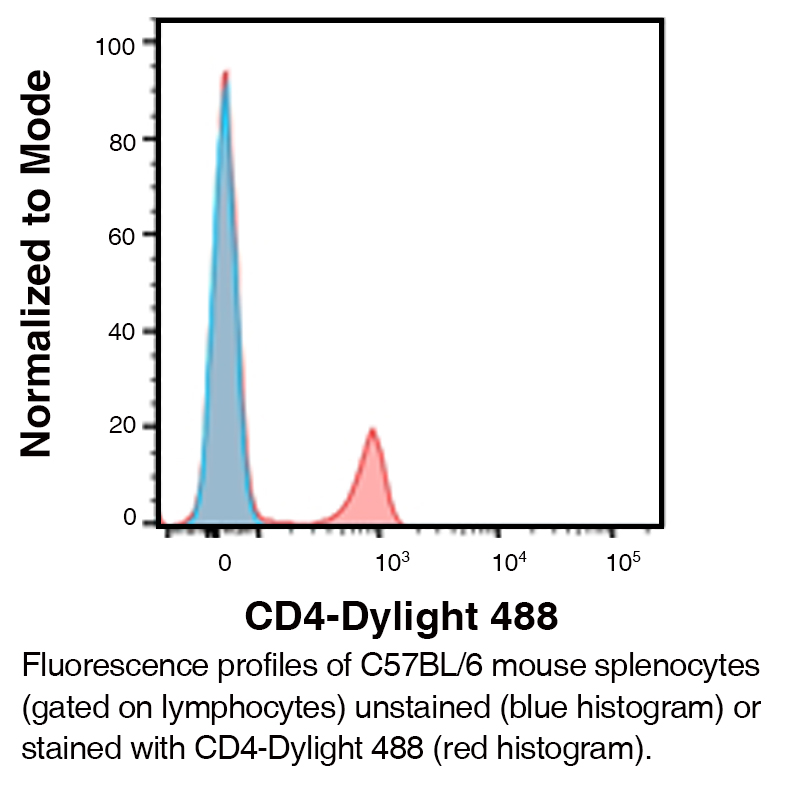Anti-Mouse CD4 (Clone GK1.5) - DyLight® 488
| Code | Size | Price |
|---|
| LEI-C1636-50ug | 50 ug | £167.00 |
Quantity:
| LEI-C1636-100ug | 100 ug | £239.00 |
Quantity:
Prices exclude any Taxes / VAT
Overview
Host Type: Rat
Antibody Isotype: IgG2b
Antibody Clonality: Monoclonal
Antibody Clone: GK1.5
Regulatory Status: RUO
Target Species: Mouse
Applications:
- Flow Cytometry
- Immunocytochemistry (ICC)
- Immunohistochemistry- Frozen Section (IHC-F)
Shipping:
2-8°C
Storage:
This DyLight® 488 conjugate is stable when stored at 2-8°C. Do not freeze.
Images
Further Information
Antigen Distribution:
The L3T4 antigen is expressed by the helper/inducer subset of mouse T-cells. The antigen is present on approximately 80% of thymocytes, 20% of spleen cells and 60% of lymph node cells. The expression of L3T4 correlates with class II MHC antigen reactivity on cloned T-cell lines.
Concentration:
0.2 mg/ml
Conjugate/Tag/Label:
DyLight® 488
Format:
This DyLight® 488 conjugate is formulated in 0.01 M phosphate buffered saline (150 mM NaCl) PBS pH 7.4, 1% BSA and 0.09% sodium azide as a preservative.
Formulation:
This DyLight® 488 conjugate is formulated in 0.01 M phosphate buffered saline (150 mM NaCl) PBS pH 7.4, 1% BSA and 0.09% sodium azide as a preservative.
Long Description:
CD4 (cluster of differentiation 4) is a glycoprotein expressed on the surface of T helper cells, regulatory T cells, monocytes, macrophages, and dendritic cells. CD4 interacts with class II molecules of the major histocompatibility complex (MHC) enhancing the signal for T-cell activation.1
NCBI Gene:
12504
Target:
CD4
References
1. Hendrickson WA et al. (1994) Structure 2: 59
Related Products
| Product Name | Product Code | Supplier | Anti-Mouse CD4 (Clone GK1.5) - DyLight® 650 | LEI-C1640 | Leinco Technologies | Summary Details | |||||||||||||||||||||||||||||||||||||||||||||||||||||||||||||||||||||||||||||||||||||||||||||
|---|---|---|---|---|---|---|---|---|---|---|---|---|---|---|---|---|---|---|---|---|---|---|---|---|---|---|---|---|---|---|---|---|---|---|---|---|---|---|---|---|---|---|---|---|---|---|---|---|---|---|---|---|---|---|---|---|---|---|---|---|---|---|---|---|---|---|---|---|---|---|---|---|---|---|---|---|---|---|---|---|---|---|---|---|---|---|---|---|---|---|---|---|---|---|---|---|---|---|---|
| Anti-Mouse CD4 (Clone GK1.5) - PerCP | LEI-C1840 | Leinco Technologies | Summary Details | ||||||||||||||||||||||||||||||||||||||||||||||||||||||||||||||||||||||||||||||||||||||||||||||||
| Anti-Mouse CD4 (Clone GK1.5) - Purified in vivo PLATINUM™ Functional Grade | LEI-C2838 | Leinco Technologies | Summary Details | ||||||||||||||||||||||||||||||||||||||||||||||||||||||||||||||||||||||||||||||||||||||||||||||||



